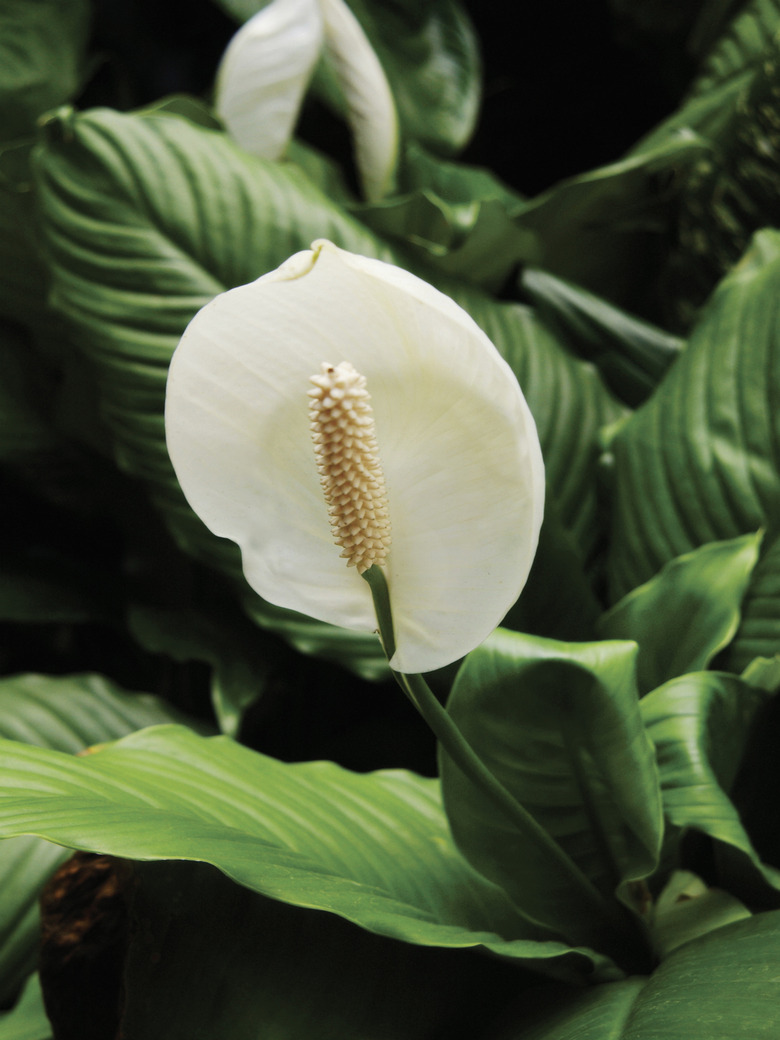Peace Lily Turning Yellow
Peace lilies (Spathiphyllum spp.) work well as houseplants because of their distinctive foliage and undemanding character. They grow outdoors only in the frost-free climates of U.S. Department of Agriculture plant hardiness zones 10 through 12. Because they are most likely grown out of their tropical element, peace lilies might develop yellowing leaves — known as chlorosis — from a number of causes.
Environment
Step 1
Peace lilies come from the tropics of Central and South America or the Malay archipelago, the island chain between Southeast Asia and Australia. A rain forest floor dweller, peace lilies grow best in moist, well-draining soil rich in humus. Their home environment is warm — between 65 and 90 degrees Fahrenheit — with high humidity and partial to full shade. A home's interior is no substitute for the rain forest floor and the plants signal problems in several ways, including chlorosis.
- Peace lilies (Spathiphyllum spp.)
- A rain forest floor dweller, peace lilies grow best in moist, well-draining soil rich in humus.
Water
Step 1
Peace lily leaves will yellow when the plant gets too much water. Water leaches quickly through its native soil, so the plant cannot withstand soggy soil. Yellowing leaves disclose the plant's effort to compensate for engorged tissue and rotting roots by reducing its top growth. Leaves may also yellow with too little water although your first clue will be a general drooping of the plant. If left dry too long, the leaves will begin turning yellow as the plant starts to go dormant. If water is retained around roots, repot the plant in a compost-heavy potting mix and allow the plant to go dry to the point of beginning to droop a bit before watering.
Fungal Root Rots
Step 1
In addition to decay caused by too much water, peace lilies suffer from two fungal root rot diseases. Cylindrocladium root rot, caused by the fungus Cylindrocladium spathiphylli, travels from plant to plant. Its first sign is yellowing lower leaves and, occasionally, slight wilting. By the time brown spots begin developing and lower portions of the leaf stalks begin rotting, the plant is a goner. The second fungus, Pythium parasitica, is a soil-borne fungus that thrives in wet and waterlogged soils and can be spread by fungus gnats, a common pest in potting soil that has spent the summer outdoors. Its symptoms include chlorosis — yellowing leaves and drooping leaves. Both root rots work quickly to produce a black, mushy mess of roots and lower crown.
- Peace lily leaves will yellow when the plant gets too much water.
- If water is retained around roots, repot the plant in a compost-heavy potting mix and allow the plant to go dry to the point of beginning to droop a bit before watering.
Other Causes
Step 1
Yellowing leaves might be a signal your peace lily lacks two micronutrients — iron and manganese, particularly in winter when the soil chills. Try setting the plant on a warm surface, such as a radiator hood, where the soil can warm, before adding fertilizer with micronutrients at a rate of 1 teaspoon per 1 gallon of water, or according to package directions. Whiteflies may cause yellow spots on leaves, but are likely to appear as the white cloud that rises when plant leaves are disturbed, long before they do enough damage to cause yellow spots. If only a few leaves yellow and die, your peace lily may be shedding a few old leaves to make way for new growth.
References
- Missouri Botanical Garden: Spathiphyllum (Group)
- University of Florida IFAS Extension: Spathiphyllum x "Clevelandii""
- University of Florida Mid-Forida Research and Education Center: Spathipyllum Production Guide
- University of California Statewide Integrated Pest Management Program: Pythium Root Rot
- University of Florida Mid-Forida Research and Education Center: Diseases of Spathipyllum
- Penn State Extension: Spathipyllum Diseases
- University of Illinois Extension: Peace Lily
